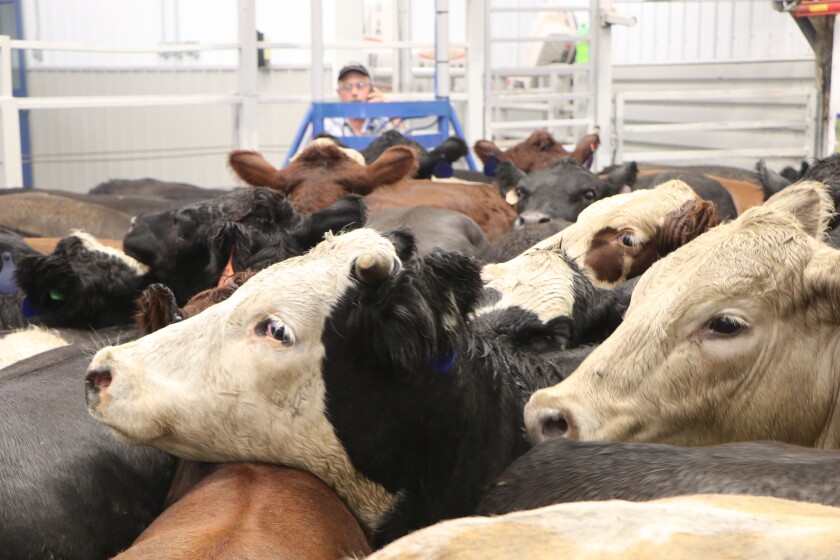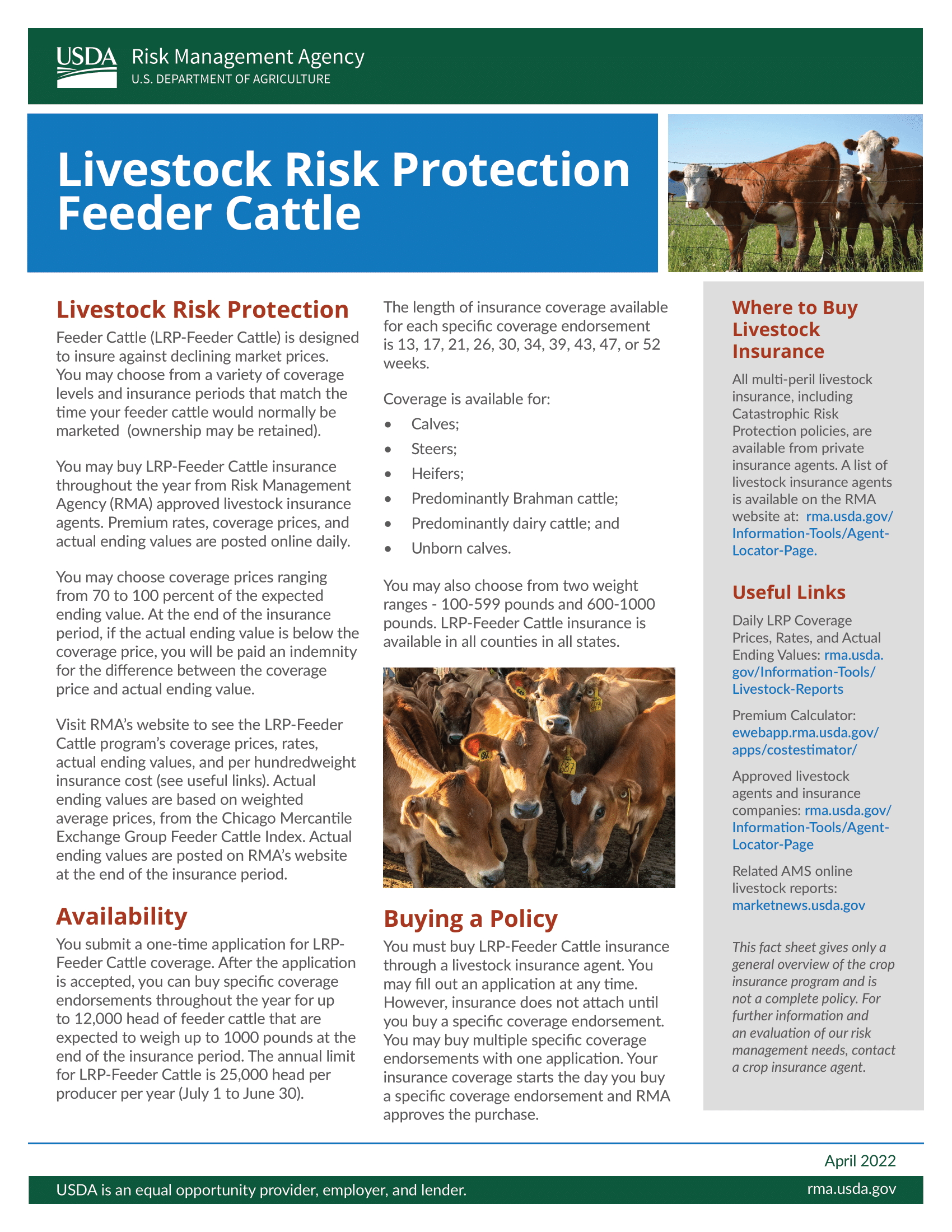Trick Variables to Consider When Choosing Livestock Danger Security (LRP) Insurance Policy
When evaluating options for Livestock Danger Security (LRP) insurance coverage, a number of crucial variables require careful consideration to make sure reliable threat management in the agricultural industry. Picking the appropriate protection alternatives tailored to your details animals procedure is vital, as is understanding exactly how superior expenses associate with the degree of defense used. Furthermore, the eligibility criteria for various kinds of livestock and the flexibility of the plan to adjust to altering circumstances are essential elements to consider. Additionally, the efficiency and openness of the insurance claims process can significantly influence the general experience and monetary outcomes for animals producers. By purposefully navigating these critical variables, manufacturers can safeguard their financial investments and reduce potential dangers effectively.
Coverage Options
When thinking about Animals Threat Protection (LRP) insurance coverage, it is essential to understand the different protection alternatives available to reduce dangers in the farming field. Animals Risk Protection (LRP) insurance coverage uses various insurance coverage alternatives customized to meet the diverse needs of livestock producers. Bagley Risk Management. One of the primary protection choices is cost protection, which secures versus a decrease in market costs. Manufacturers can select the protection degree that lines up with their cost danger management goals, allowing them to safeguard their operations against possible financial losses.
Another essential protection option is the recommendation duration, which figures out the length of time the coverage is in effect. Manufacturers can choose the endorsement duration that finest suits their manufacturing cycle and market conditions. Additionally, insurance coverage levels and prices vary based upon the kind of livestock being guaranteed, providing manufacturers the versatility to customize their insurance policy prepares according to their details demands.
Understanding the various protection options readily available under Livestock Risk Security (LRP) insurance is critical for producers to make enlightened decisions that properly safeguard their animals operations from market unpredictabilities.
Premium Prices

Animals Danger Protection (LRP) insurance provides essential coverage alternatives customized to mitigate threats in the farming field, with a significant element to think about being the estimation and structure of premium costs. These consist of the type and number of animals being guaranteed, the coverage level picked, the existing market prices, historical cost information, and the length of the protection duration.
Premium costs for LRP insurance are typically calculated based upon actuarial data and take the chance of analysis models. Insurance companies examine historic information on livestock prices and manufacturing costs to establish a proper premium that shows the level of danger involved. It is necessary for livestock manufacturers to thoroughly evaluate premium expenses and insurance coverage choices to guarantee they are effectively safeguarded versus potential monetary losses as a result of unfavorable market problems or unexpected occasions. By recognizing exactly how exceptional costs are determined and structured, manufacturers can make informed decisions when picking the right LRP insurance coverage for their procedure.
Qualified Animals
The resolution he said of qualified animals for Animals Risk Defense (LRP) insurance protection includes cautious consideration of specific standards and attributes. Livestock types that are typically qualified for LRP insurance coverage include feeder livestock, fed lambs, cattle, and swine.
Feeder cattle, for instance, are commonly eligible for LRP insurance coverage if they fall within defined weight ranges. Lambs are one more category of livestock that can be taken into consideration for LRP insurance, with aspects such as weight and age playing an essential duty in determining their eligibility.
Prior to selecting LRP insurance coverage for animals, producers ought to meticulously evaluate the eligibility criteria detailed by the insurance supplier to guarantee their animals meet the needed needs for coverage.
Policy Flexibility
Policy versatility in Animals Threat Protection (LRP) insurance allows producers to tailor protection to match their details needs and risk management techniques. This versatility equips animals producers to personalize their insurance plan based upon aspects such as the kind of animals they have, market problems, and specific threat resistance degrees. One crucial element of policy versatility in LRP insurance coverage is the capability to pick insurance coverage degrees that line up with the manufacturer's monetary goals and risk exposure. Producers can select protection degrees that secure them against prospective losses due to variations in animals prices, guaranteeing they are appropriately insured without paying too much for unneeded protection. Furthermore, LRP insurance policy offers flexibility in plan duration, allowing manufacturers to select protection periods that best fit their manufacturing cycles and marketing timelines. By using customizable alternatives, LRP insurance coverage makes it possible for manufacturers to successfully handle you can try these out their danger exposure while safeguarding their animals operations versus unanticipated market volatility.
Claims Process
Upon experiencing a loss or damages, manufacturers can start the cases process for their Livestock Danger Defense (LRP) insurance by quickly calling their insurance policy supplier. It is essential for manufacturers to report the loss as quickly as feasible to expedite the insurance claims process. When connecting to the insurance policy service provider, manufacturers will certainly require to provide comprehensive details concerning the incident, including the date, nature of the loss, and any type of appropriate documents such as vet documents or market prices.

After the evaluation is complete, the insurance coverage service provider will certainly decide pertaining to the insurance claim and connect the outcome to the manufacturer. The producer will certainly receive payment according to the terms of their Animals Danger Defense (LRP) insurance policy if the case is approved. It is vital for manufacturers to be accustomed to the insurance claims procedure to make certain a smooth experience in the event of a loss

Conclusion
To conclude, when choosing Livestock Risk Protection (LRP) insurance, it is important to think about protection options, premium costs, eligible animals, plan adaptability, and the insurance claims process. These essential elements will help make certain that herdsmans and farmers are appropriately shielded versus Continue prospective risks and losses associated with their animals procedures. Making a notified decision based upon these factors to consider can eventually result in better economic safety and assurance for livestock producers.
Animals Danger Protection (LRP) insurance policy supplies different coverage alternatives tailored to meet the varied requirements of livestock manufacturers.The decision of qualified animals for Livestock Risk Defense (LRP) insurance policy coverage entails cautious consideration of specific standards and attributes.Policy adaptability in Livestock Threat Security (LRP) insurance policy allows producers to customize protection to suit their certain needs and take the chance of management approaches.Upon experiencing a loss or damage, manufacturers can initiate the insurance claims procedure for their Livestock Threat Protection (LRP) insurance coverage by promptly contacting their insurance policy company.In verdict, when selecting Animals Threat Protection (LRP) insurance coverage, it is essential to think about insurance coverage options, premium expenses, qualified animals, policy flexibility, and the insurance claims procedure.